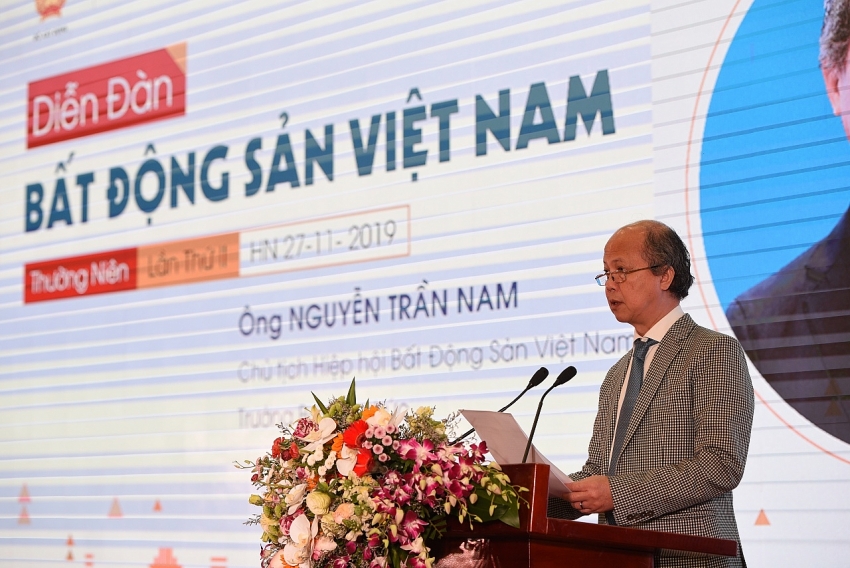Five opportunities in Vietnam’s real estate market
 |
| Nguyen Tran Nam, chairman of the VNREA, telling about the opportunities real estate investors could seize in Vietnam |
At the annual Vietnamese Real Estate Forum today, November 27, 2019, Nguyen Tran Nam, chairman of the Vietnam Real Estate Association (VNREA), said that over the last three years, this market is developing stably, positively, and professionally, while risks are reducing significantly, and confirmed its role in the economy and the motivation for the development of other sectors and markets.
Since the beginning of the year, there have been so many complicated international and regional fluctuations, which decreased the revenues and profits of listed businesses.
Besides, most real estate companies are of a small scale, utilising loans from banks, while the government has tightened credit lines for the real estate market, causing difficulties for some firms. Meanwhile, legal obstacles cooled down several segments like condotel and officetel.
Thereby, the VNREA forecast numerous difficulties for the market and a decreasing trend. According to the Vietnam Association of Real Estate Brokers, in the third quarter of this year, the market is still on a downtrend, especially in Hanoi and Ho Chi Minh City.
Specifically, in Hanoi, the total number of newly-released apartments in the third quarter has declined by 2,200 compared to the second quarter, and by 4,000 on-year.
Five opportunities
Based on this situation, the VNREA pointed out five opportunities in the market.
First, the market is still stable, thanks to positive macroeconomic signals.
Second, the demand for housing is still large. As the world’s fifteenth largest population and Southeast Asia's third-ranking country, urban areas show the highest demand for housing every segment, including apartments, offices, hotels, and commercial buildings.
Third, there remains empty room for tourism real estate, resorts, and industrial real estate, which are considered a light spot of the market in the medium and long term. It is forecast that Vietnam will need dozens of thousands of new hotel rooms to meet the demand of 20 million international arrivals every year, staying for 5-7 days each, and 85 million local tourists staying for 3-4 days.
Meanwhile, industrial real estate is also developing rapidly because Vietnam has been one of the most attractive destinations in Southeast Asia for manufacturing companies. Thereby, industrial real estate will develop significantly in the short, mid, and long term if the state issues more encouraging policies.
Fourth, foreign direct investment (FDI) into real estate is increasing. According to the Ministry of Planning and Investment's Foreign Investment Agency, total registered FDI capital was $29.11 billion, up 4.3 per cent on-year. Of this, real estate ranked second with the total investment of $2.98 billion, capturing 10.2 per cent.
Fifth, infrastructure has been developing well over the past decade. Total infrastructure investment has exceeded 10 per cent of the GDP, surpassing most Southeast Asian economies. In the last seven years (2012-2019), the country has build an additional 838km of highways, which is a key motivation for socioeconomic development.
What the stars mean:
★ Poor ★ ★ Promising ★★★ Good ★★★★ Very good ★★★★★ Exceptional
Related Contents
Latest News
More News
- PM orders investment model for North–South high-speed rail (December 22, 2025 | 17:43)
- First members of Danang International Finance Centre revealed (December 22, 2025 | 17:39)
- Securing capital and efficiency for Vietnam’s 2026-2030 growth ambitions (December 17, 2025 | 10:00)
- Driving double-digit growth through green and circular transformation in Vietnam (December 17, 2025 | 09:00)
- Vietnam bucking trend in the global M&A landscape (December 16, 2025 | 14:20)
- Vietnam’s green transition demands collective financial action (December 15, 2025 | 12:00)
- VIR workshop highlights capital and policy for sustainable development (December 15, 2025 | 11:00)
- National Assembly approves pilot mechanisms to accelerate major projects in Hanoi (December 12, 2025 | 11:29)
- Vietnam eases policy approval requirements, simplifies foreign and outbound investments (December 11, 2025 | 17:53)
- Unpacking new momentum in Vietnam’s M&A market (December 10, 2025 | 09:59)

 Tag:
Tag:


























 Mobile Version
Mobile Version